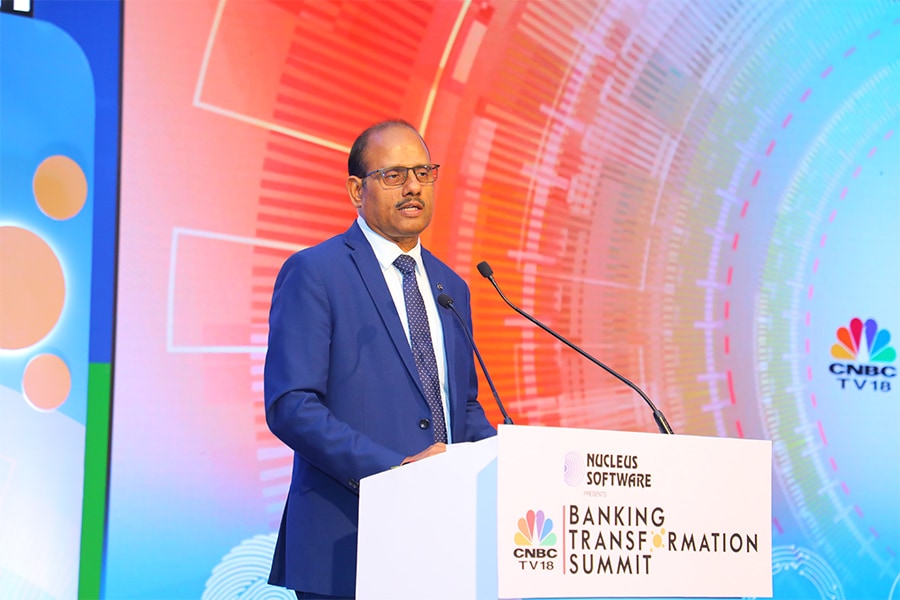
An air of momentous anticipation hung over the second edition of CNBC-TV18 Banking Transformation Summit, presented by Nucleus Software, as the country’s top financial regulators, decision-makers, bankers, and emerging industry stars came together in Mumbai for an evening of landmark deliberations and pioneering insights.
During introductory remarks delivered on the red carpet, J. Swaminathan, Deputy Governor, Reserve Bank of India, assessed the risks facing banks, while leaders such as Y.S. Chakravarti, MD & CEO, Shriram Finance, and Aseem Dhru, MD & CEO, SBFC Finance, remained cautiously optimistic about the future of Indian finance. Many of these themes would find greater resonance as the evening progressed.
Shereen Bhan, Managing Editor, CNBC-TV18, delivered a welcome address to contextualize the broad sweep of progress that has brought India’s banking sector to the cusp of a historic transformation. Her address focussed on delivering equity and empowerment in the quest for broad-based economic growth. How these objectives might shape the country’s policymaking and regulatory framework became clearer when Mr. Swaminathan delivered his much-awaited keynote address. He reminded banks and financial institutions of the need to maintain strong fundamentals. “The sector must prioritize financial and operational resilience, alongside strong corporate governance,” he said.
During a fireside chat with Latha Venkatesh, Executive Editor, CNBC-TV18, the Deputy Governor reiterated his belief in liquidity cycles, allaying concerns about lower deposits. “This is a part of evolution. There are multiple options for financial savings today and this will be typically cyclical.”
Another policymaking luminary present at the summit was V. Anantha Nageswaran, Chief Economic Adviser to the Government of India. Fresh off the announcement of slowest GDP growth in in five quarters, Mr. Nageswaran said, “We are a low income, aspirational country. We need to sustain our growth rates, whether it is economic growth or credit growth.” He identified new opportunities for banks to act as support systems for Indian businesses expanding abroad.
The summit was the final curtain call for two stalwarts of the banking industry who completed their respective tenures at the helm of two of India’s most revitalized and resurgent banks. Dinesh Khara had retired from his position as Chairman of the State Bank of India just a couple of days before, while Shyam Srinivasan, now former Managing Director & CEO, Federal Bank, would soon hand over the reins to his successor. Speaking to Shereen Bhan, the leaders were measured in their assessment of the changes they have witnessed.
For Mr. Khara, technology was the key differentiator. “We have started leveraging analytics in a very big way in terms of profiling risk,” he said. Mr. Srinivasan, on the other hand, touted new drivers of organizational success, such as the ability to deliver cheap credit through enhanced productivity and efficiency. The two men displayed different approaches to leadership transitions too, with Mr. Khara choosing not to dole out advice to his successor, Challa Sreenivasalu Setty, while Mr. Srinivasan promising to have a docket ready for KV Manian, his successor at Federal Bank.
Sustained growth was on everyone’s mind, especially the trio of high-profile banking leaders who joined the panel discussion on ‘Filling the Credit Gap to Fuel Economic Growth,’ including A.K. Tewari, Managing Director, State Bank of India; Prashant Kumar, MD & CEO, Yes Bank; and Ashok Vaswani, MD & CEO, Kotak Mahindra Bank. They were united in their belief that “the best is yet to come.” Mr. Vaswani said, “Banking sector in India is in a much better position than it has been in a very long time.” As Mr. Kumar cited the size of the opportunity as a reason to believe, Mr. Tewari highlighted better underwriting practices, saying, “Earlier, we would approve a project assuming the land would be acquired. Now, unless it is 90%-95% acquired, we don’t disburse anything.”
During a fireside chat with Ritu Singh, Deputy Editor of CNBC-TV18, Vishnu R. Dusad, Co-Founder & MD of Nucleus Software, highlighted the rapid evolution of digital lending. He remarked, “We’ve seen personal loan disbursement evolve from taking months, to weeks, to days, and now it happens in mere seconds. Today, with responsible data usage and the right technology, financial inclusion becomes more attainable.”
NBFC leaders were more circumspect when discussing growth prospects during a panel discussion on ‘Smart Lending: In the Era of Tightened Norms.’ On this panel, Y.S. Chakravarti of Shriram Finance and Aseem Dhru of SBFC Finance were joined by Jairam Sridharan, Managing Director, Piramal Capital & Housing Finance, and Raul Rebello, MD & CEO, Mahindra Finance. Their primary concern was low liquidity. “There is not a challenge in terms of availability of money, but there is a pricing pressure,” said Mr. Sridharan. Mr. Dhru and Mr. Chakravarti spoke about the evolving situation in consumer and corporate finance, respectively, while Mr. Rebello flagged potential areas of stress in an agro-centric rural economy.
Ideas on how to cope with disparate economic pressures, especially in rural areas, came forth during the final panel discussion on ‘Fintech Race for Bharat,’ which brought together prominent innovators and fintech experts to share principles they believe must underpin the design and deployment of fintech products across smaller towns and cities.
The summit closed with a vote of thanks delivered by Parag Bhise, CEO, Nucleus Software, who reaffirmed the overwhelming significance of the second edition of Banking Transformation Summit in the larger scheme of economic growth. “Digital transformation events like these are crucial for fostering dialogues and forging partnerships that drive forward-thinking solutions,” he concluded.
The pages slugged ‘Brand Connect’ are equivalent to advertisements and are not written and produced by Forbes India journalists.
